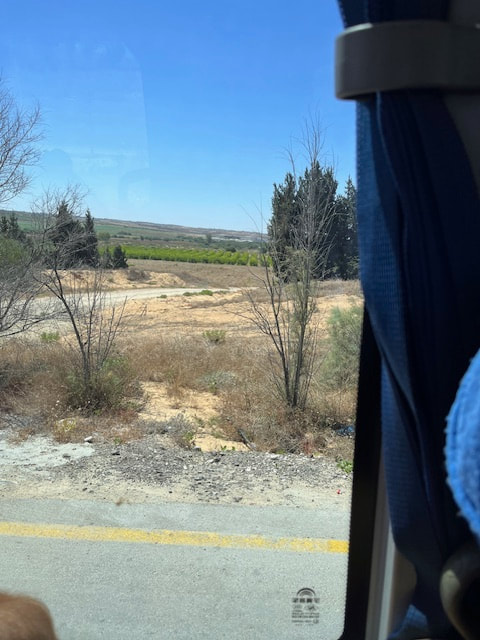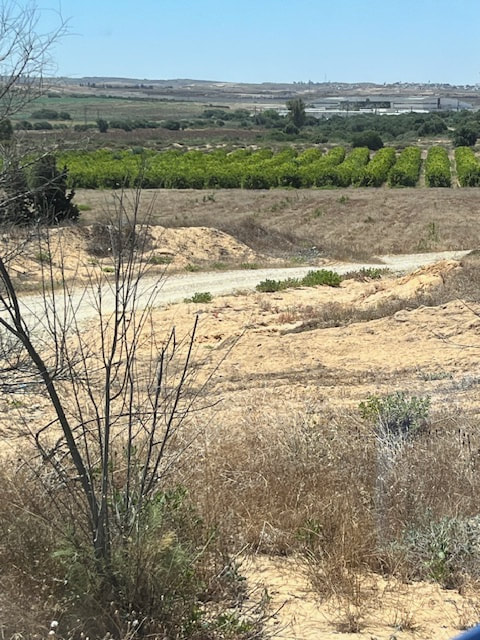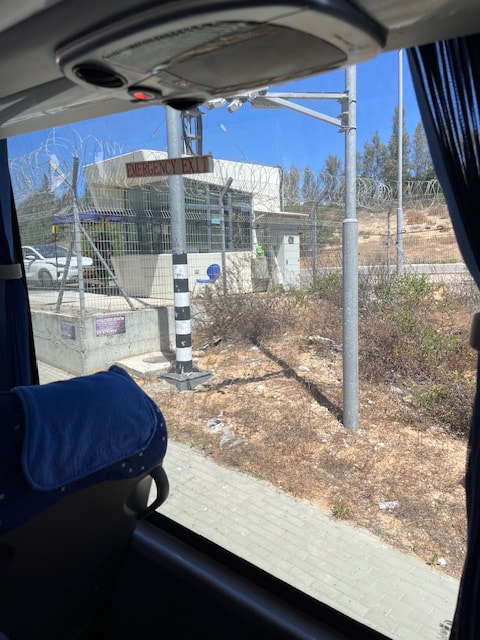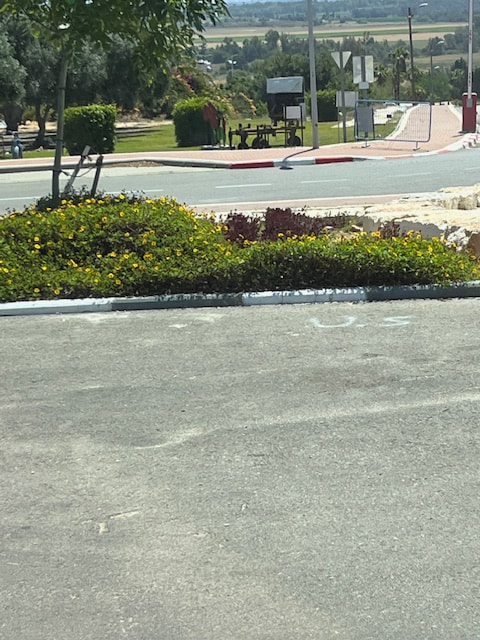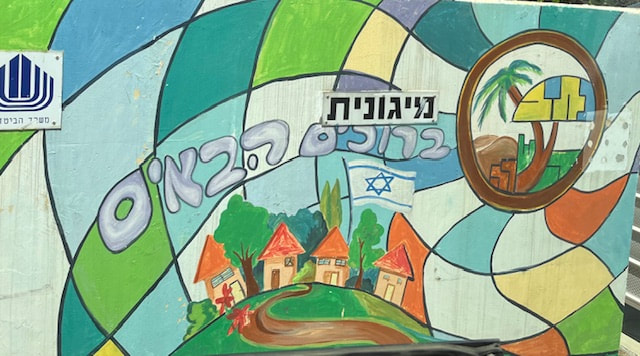
outside of a bus stop bomb shelter in Netiv Ha-Asara
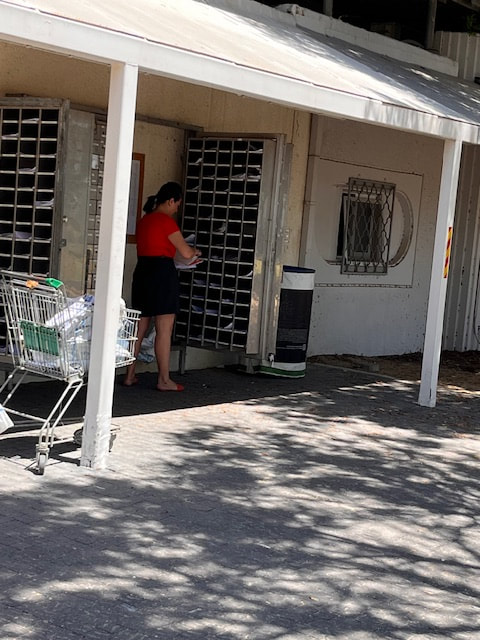
mail distribution at Netiv Ha-Asara

outside view of bus stop bomb shelter in Netiv Ha-Asara
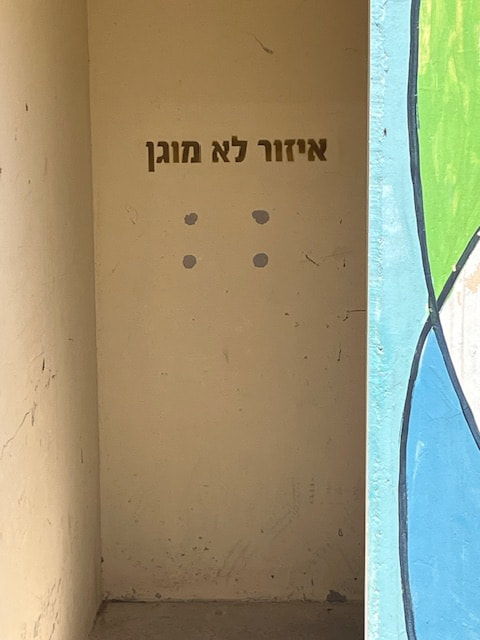
entrance to bus stop bomb shelter in Netiv Ha-Asara. Words in entrance read: Not a shielded area
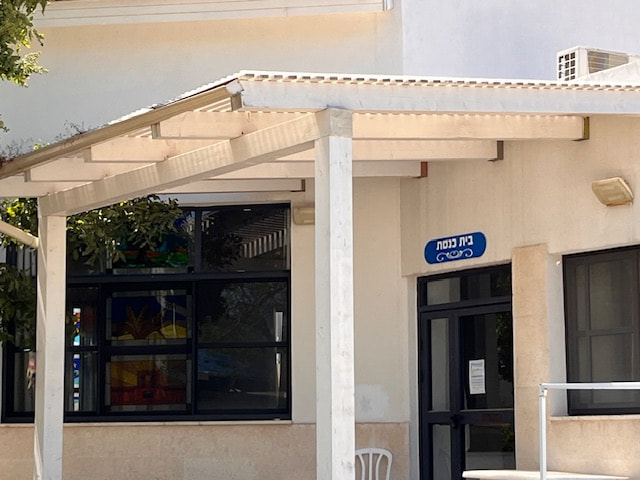
synagogue building in Netiv Ha-Asara
|
There was a day, years ago, when Hila Fenlon and her family would make quick trips and do errands in Gaza. After all, it was the next town over. Today, the crossing into Gaza that is closest to her moshav, Netiv Ha-Asara, is the Erez Crossing--a mere sixteen miles. Palestinian neighbors lived on the other side of that crossing, and Hila's family--in fact, everyone who lived on her moshav (in her village) enjoyed free exchange of travel and economy.
Then, Israel withdrew from Gaza in 2005. The border became unsafe. Hila and her moshav then had to do something they had never imagined doing: They had to build a wall around their moshav, which included her farm. Suddenly, the free and open border had become a hostile one.
Nonetheless, the kinds of people who lived in Netiv Ha-Asara did not see these over-the-border neighbors as complete enemies. They were still neighbors, and they were close enough in location and in heart to see that these neighbors had a rough time of it. Many of them could see the need for peace clearly enough to make for a personal conviction. And, so, people living in Netiv Ha-Asara, people like Yaacov and Bilhah Inon, would help transport Gazans who needed medical care in Israel. Of all the Israelis in Eretz Yisrael, the residents of Netiv Ha-Asara were perhaps among the most sympathetic to the suffering Palestinians face.
Even so, the wall remained, a reminder of the changes in the neighborhood. All over the moshav were bomb shelters. There were bomb shelters in every building. There had to be a certain number of shelters in a specific metric area. The bus stops where children waited to go to school were bomb shelters. Many shelters were painted with works of art--colorful, cheery, hopeful elements that resident artists added to the landscape. While many Israelis have outside of a minute to find a shelter when an alarm sounds, residents this close to the border with Gaza have fifteen seconds.
And, yet, on Oct. 7, as Hila and her family slept, at 6:00am, highly trained and prepared terrorists hang-glided over the wall of the moshav and into the streets and squares of this community. There was no time to prepare. Hila and her family made it to a shelter, but as the terrorists went house to house killing residents, and burning down homes, many were not as lucky. And it was luck. There were so many moments that could have gone the other way for Hila, if only through a slight change in timing, location, or attention.
|

doorless bomb shelter at the site of the Nova Festival Massacre
A Note About Bomb Shelters
It has been a long time since I have lived in Israel (twenty-four years). I was there just before the second intifada. At that time, it was not the case that every home and building had a bomb shelter, as is the case now. So, I was amazed to learn how and for what kinds of protection the shelters are constructed.
I pictured a "duck-and-cover" era bunker in the ground, filled with food, supplies, and sleeping cots. Most bomb shelters in Israel are very different than this description. Bomb shelters are meant to protect people from bombs descending from above. Additionally, should there be damage to the shelters, it is important that those seeking shelter would be able to exit the rubble. As such, bomb shelters do not have doors that lock. A lock would prevent exiting.
In fact, some of the shelters I saw during my travels did not even have doors. They are constructed like a square, concrete tube, with walls on either end. These walls are constructed about a foot or more from the edge of the tube, leaving a gap for people to enter and exit. Again, this is a reasonable design for quick entry, easy exit, and protection from bombs from above.
Another design has no door at all: It is a concrete structure with no door that looks like a small bathroom in a national park--you enter and then turn a corner 180 degrees, so that you are ensconced in the concrete walls--much like entering the bottom of a capital letter "G".
Again, these designs are made for aerial bombs. They are not designed to protect from terrorists. The logic here is that if terrorists were to come, they would be intercepted by the IDF before they could get to the populace in any great numbers.

tube-like bomb shelter at the site of the Nova Festival Massacre
|

Opening to the tube-like bomb shelter at the Nova Festival Massacre site
|
In Her Own Words
Here is a video of Hila talking about that horrifying morning, when twenty people in her village were murdered:
|
|
Bomb Shelter Becomes Memorial
One older woman, a resident of Netiv Ha-Asara, was stuck in a rudimentary shelter. When the terrorists came, and the alarm sounded, she was out for a morning walk. It was her regular exercise routine. She ran to the shelter (the G formation version). Members of the community serve as a first responders, and there were first responder neighbors who tried to get to her. They tried to reach her, so that they could help her get to a safer location.
They were killed just steps from her. She remained in the shelter where terrorists found her. They shot her nine times. Today, the bullet holes in the wall are numbered as part of a makeshift memorial.
|
Neighbors and Enemies
There was a resident who shouted to the terrorists: I am not your enemy!
Indeed, these residents were among the many Israelis who prayed, hoped, believed in, and worked for peace and justice between them and their Palestinian neighbors. It is a deep, sad irony that these were among the first victims on Oct. 7.
 mandalas made by Netiv Ha-Asara residents under direction of Bilhah Inon. These works of art made from recycled materials decorate one of the buildings in Netiv Ha-Asara mandalas made by Netiv Ha-Asara residents under direction of Bilhah Inon. These works of art made from recycled materials decorate one of the buildings in Netiv Ha-Asara
Bilhah and Yaacov Inon: Peace, Love and Works of Art (The Things We Lose)
My May 10 blogpost entitled, "Prophecy and Protest" tells the story of Maoz Inon. Maoz is the tourism professional and peace activist who builds neighborhood economies and forges business partnerships with Palestinians in Israel. He also mourns his parents, Bilhah and Yaacov who were killed on Oct. 7.
Bilhah and Yaacov Inon, Maoz's parents, were killed on Oct. 7 when their home in Netiv Ha-Asara was burned down to its foundation by terrorists. Yaacov was an agronomist who envisioned and worked with a team to develop a more productive strain of sesame that could be grown in Israel. Bilhah was an artist, who utilized recycled materials in artwork long before it was a "thing." Before she died, she was working with community members on projects, teaching them to make mandalas.
Outside their decimated home one finds a beautiful "junk"yard full of old equipment interesting pieces of found and created art--all part of Bilhah's workshop.
All that remains of the house is its floor, laid out like a large-scale model of a floor plan, as if on paper. Paper that did not burn. The site is another of too many memorials.
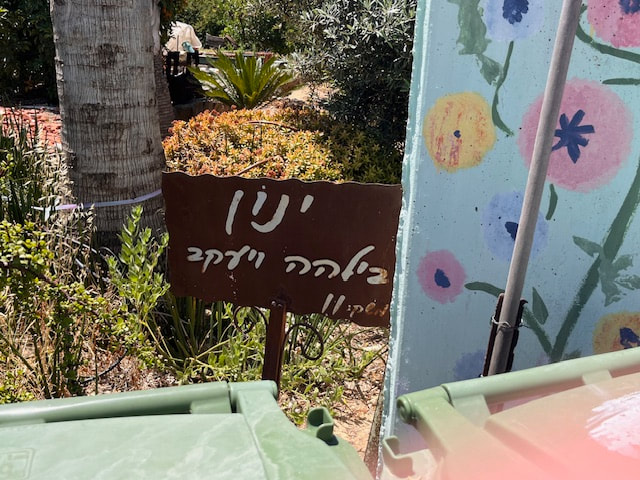
Sign reads: Inon, Bilhah and Yaacov
|
